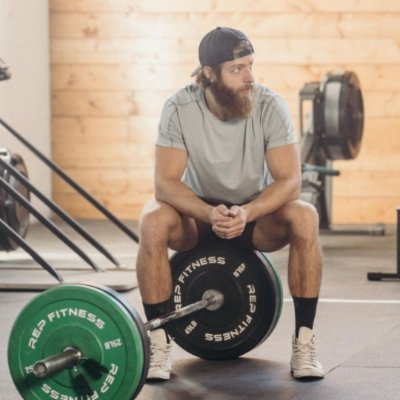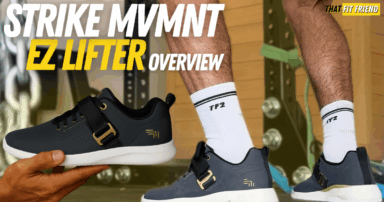That Fit Friend is supported by its readers. I [Jake Boly] run this site myself and buy the gear I review. If you purchase through my site, I may earn commissions on sales, read more here!
The PUMA PWRFRAME TR is a budget-friendly training shoe from PUMA designed for versatile training. This shoe is built with a responsive high-rebound midsole and PUMAGRIP outsole to promote dynamic performance.
As someone who is constantly training the find the best cross-training shoes on the market, I was excited to put the PUMA PWRFRAME TR to the test. More specifically, I had heard good things about this model for versatile training.
Overall, I’ve been impressed with the PWRFRAME TR, especially for dynamic gym workouts. There are a few areas where this model falls short and I’ll discuss those below, but for its price, it’s a pretty good training shoe.
Who Should Invest In the PUMA PWRFRAME TR?
The PUMA PWRFRAME TR is a budget-friendly training shoe from PUMA that works well for versatile training and class-style workouts. I think if you’re wanting to save money and need a shoe for these training contexts, then you’ll enjoy this model.
This shoe’s PROFOAM EVA foam midsole with PUMA’s PWRFRAME tech gives this model a nice responsive base to train on, and this shoe does well for HIIT, athletic-style training, and light strength training.
I also could see this model being great for beginners and anyone who isn’t super niche with their training that wants a shoe for a little bit of everything. This model has a nice level of versatility which is great for dynamic weekly training.
Despite its versatility, there are areas where this shoe will fall short. For example, if you want a training shoe for heavier lifting, you’ll want to pass on this model. In addition, this shoe will likely not be the best option for wide feet and outdoor training.
PUMA PWRFRAME TR Pros
Across all of my workout sessions and over the course of my review process with the PUMA PWRFRAME TR, I found a few things to like about this shoe.
- Good Budget Training Shoe for Class-Style Workouts
- PWFRAME Midsole Is Lightweight and Responsive
- PUMAGRIP Outsole Has Good Traction
The first to like about the PUMA PWRFRAME TR is this shoe’s performance for versatile training and class-style workouts. If you’re wanting this shoe primarily for classes and HIIT, then I think you’ll enjoy this model’s overall performance.
This shoe comes in at $80 USD and is often on sale for less, so if you want to spend less than $100 USD on a consistent training shoe for versatile training I think you’ll like this model. I thought this shoe felt very similar to models like the Reebok Speed 22 TR and Nike SuperRep Go 3.
The PUMA PWRFRAME TR should match your training needs well if you’re consistently doing things like box jumps, agility work, jump rope, light strength training, and taking classes.
The second thing to like about the PWFRAME TR is its PWRFRAME midsole. This shoe’s midsole is built with a PROFOAM high-rebound EVA and I thought it performed well for plyometrics and explosive training.
I like the “bounce” that you get from this shoe and if you typically prefer training shoes with thicker midsoles that feel somewhat similar to running shoes, but with a little more density, then I think you’ll enjoy how this shoe’s midsole feels.
The final aspect to like about the PWRFRAME TR is its outsole construction. Like most of PUMA’s training shoes, this model features a PUMAGRIP outsole construction that covers its forefoot and heel.
This rubber material has a nice “stickiness” to it and I thought it did a good job of providing traction on different surfaces. Whenever training shoes feature exposed foam on their soles I’m always a little weary when it comes to their grip performance.
The PWRFRAME TR has been a nice anomaly in this context and I have yet to have issues with traction in this shoe. If you’re using these for rubber gym floors, wooden floors, and turf, then you should find you have enough grip in them.
PUMA PWRFRAME TR Cons
While the PUMA PWRFRAME TR performs pretty well in the gym for a budget-friendly trainer, there are a few cons that I’ve found with this shoe.
- Heel Slip May Be An Issue for Some
- Tongue Security Could Be Better
- Not the Best Model for Wide Feet
The first drawback that I have with the PUMA PWRFRAME TR is that you may experience some heel slip in this shoe depending on your foot anatomy and fit preferences. This shoe features a flared heel and low-profile boot construction.
These features aren’t necessarily things that instantly lead to heel slip, but since this model runs a little long I did find myself having to crank the laces pretty tight to prevent slipping out of these while training.
More specifically, I don’t always love tying my shoes super tight, so I found this to be a little annoying at times. The heel slip and lace tightening issue are also why you see me wearing thicker trail socks in all of my training photos in these.
Another drawback with the PUMA PWRFRAME TR is that its tongue can slide a little bit while training. This shoe’s tongue is built wide which is great for helping to prevent this, but since it lacks a gusset, I still found it to move at times.
This is also more noticeable when you wear these shoes a little looser. My advice is to loosen this shoe well and lay the tongue perfectly flat before lacing and tightening them to ensure you’re going to get the most out of your tongue security.
The final drawback that I have with the PUMA PWRFRAME TR is that it’s not be a good shoe for wide feet. Granted, PUMA is not really a company known for making wide-foot-friendly shoes, this model is no different.
That being said, I do feel like this shoe feels slightly wider than something like the PUMA Fuse 3.0. I think this is due to its more voluminous upper. Regardless, if you have E-width feet or wider feet, you may want to pass on these shoes.
Performance Breakdown
To discuss the performance of the PUMA PWRFRAME, I’ll cover how these shoes perform in a variety of contexts. I’ll break down their performance for lifting, versatile training, short runs, and daily wear.
This way if you’re considering these shoes you can cross-reference their performance in various contexts to make sure they match your individual training needs and asks.
Testing the PUMA PWRFRAME TR for Lifting
When it comes to weight training, I think you’ll be a little limited with the PUMA PWRFRAME TR’s performance. This shoe will work for light strength training, but it hits its wall pretty fast for heavier strength work.
For example, when working up to 315 lb squats in this shoe, I felt pretty unstable and it was not a great shoe for moderate to heavy strength training. I know it’s not designed for that, so it’s not necessarily a knock against this shoe, but it’s a limitation to note nonetheless.
On top of squatting, these shoes also fell short for exercises like deadlifts and Romanian deadlifts. The thicker midsole, beveled heel, and bit of toe spring made it hard to actively ground the feet in this shoe and I’d cap your loading with these movements to 225 lbs or lower.
For light strength training or accessory-focused days, these shoes should be fine, though. If you’re wanting them for a light strength day where you’re loading is staying below 225 lbs, then they should be a good shoe for your needs.
Testing the PUMA PWRFRAME TR for Versatile Training
For the most part, the PUMA PWRFRAME TR performed well for versatile workouts. This is definitely a shoe that will find its best uses for class-style training, HIIT workouts, and other athletic-style sessions.
This shoe’s PROFOAM high-rebound EVA midsole is responsive and it gives this shoe a nice “bounce” when doing things like box jumps and lateral explosive work. The PWRFRAME midsole tech was also a cool feature for additional stability during lateral work.
On top of its midsole, the PUMAGRIP on the outsole does a pretty good job in most versatile training settings regarding traction. On turf, I didn’t have traction issues with this shoe despite it having some exposed foam on the midfoot, and on rubber gym floors these performed well.
My only complaints with this model regarding its performance for versatile training revolve around its tongue and boot construction. The tongue isn’t gusseted so it can slide during certain workouts which can be frustrating at times.
On top of this, I noticed that the low-profile boot can be a little prone to heel slip if you’re not tightening this shoe a ton. I don’t always like cranking my shoes super tight for every workout and in this model you don’t really get the variability to choose not to, so if you’re similar, then you may want to consider that.
Testing the PUMA PWRFRAME TR for Short Runs and Daily Wear
When it comes to short runs, the PUMA PWRFRAME TR should do a fairly good job for a couple of miles here and there. think if you’re tacking on a little cardio pre or post-workout, then this should be a training shoe that works for your needs.
For long-distance runs, I’d pass on this shoe because it can feel a tad heavy for longer runs and you’ll get more out of their durability if you save them for training and short runs. Plus, the exposed foam on the midfoot can break down faster due to concrete friction.
For daily wear and walking, the PWRFRAME TR does an okay job. It’s comfortable for long walks and if you’re using them on dry days, then they should perform pretty well without changing the acceleration of their durability.
My main issues with this model for daily wear are that the toe box’s width can be a little snug for all-day wear and that it does give you a slightly more “forward” feeling with its last construction. The latter can be great for training and walking, but it wasn’t my favorite fit and feel for standing all day.
PUMA PWRFRAME TR Sizing
In the PUMA PWRFRAM TR, I think most athletes and lifters should be safe going true to size in this model. The length of this model runs a tiny bit long and I’d describe the width of these shoes as being fairly neutral in nature.
To get more specific with the PWRFRAME TR’s sizing for some athletes, I think if you narrow feet and you generally have a lot of room at the end of your toe box, then you may want to size down a half size, especially if you like a snugger fit.
Neutral-width feet should have no issues with sizing. However, if you generally like snugger-fitting shoes, then you may also want to consider going down a half-size as well since these can run a smidge long.
To expand on this, because this shoe naturally runs a little long, I think if you size up too much and have a lot of room at the end of your toe box, then you could run into heel slip issues with the flared heel and low-profile boot.
- PUMA PWRFRAME TR Sizing Thoughts: Most should be safe going true to size, but they can run a little long.
If you have additional sizing and fit questions about the PUMA PWRFRAME TR, drop a comment below and I can try to you out before you invest.
Price Assessment
For the PUMA PWRFRAME TR, you can expect to pay around $80 USD. I think the price point for this model is pretty fair for the performance that comes with this shoe and its overall construction.
This is not a training shoe that’s designed to be the most premium model on the market, but I do think it can hold its own for its price, especially for someone who’s much more casual with their training or more of a beginner.

Additionally, if you compare this shoe to other budget-friendly trainers like the Reebok Nanoflex V2 and Nike MC Trainer 2, I’d put this model in the middle of the road for its performance, if not towards the top for budget trainers.
I think the big thing to realize before investing in this shoe is that it will have limitations in the gym and it’s not going to be the best shoe for every type of niche-specific training and it’s not a model that’s going to transcend its intended uses.
Construction Details
The PUMA PWRFRAME TR utilizes a few proprietary construction details that make it different from other PUMA training shoes. Below are the key details to note about this model that can influence its performance and durability.
- Heel-to-Toe Drop: N/A for this model
- Weight: 10.70 oz (for my size 10 model)
- Removable Insole: Yes
- PWRFRAME Midsole
- PUMAGRIP Rubber Outsole (forefoot and heel)
- Textile Upper
- Padded Tongue
- Beveled Heel
- 5 Core Eyelets
If you have additional construction-related questions about the PUMA PWRFRAME TR or need further clarification, drop a comment below.
Takeaway Thoughts
The PUMA PWRFRAME TR delivers a pretty strong performance for HIIT workouts and versatile training. This shoe’s PROFOAM high-rebound EVA midsole has a nice responsiveness and the PUMAGRIP rubber provides a good level of traction.
I think if you’re in the market for a budget-friendly training shoe designed for things like classes and F45 Training, then you should enjoy this model’s overall performance.
However, there are areas where this shoe falls short. For example, its durability will likely fall short for outdoor workouts, it runs a little narrow, and its stability isn’t the best for weight training.
If you have additional questions about the PUMA PWRFRAME TR, drop a comment below or reach out to me personally via Instagram (@jake_boly or @that_fit_friend).

























Add a Comment